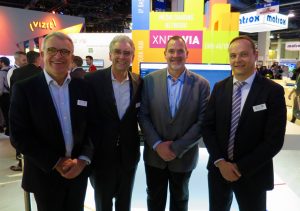NAB 2019 Reflections: EVS’s Sebastien Verlaine, Nicolas Bourdon Lay Out IP, Virtualized Future
VIA network has been tapped by F&F Productions and Mobile TV Group
Future workflows and product strategies were on full display at the EVS booth during NAB 2019, and there were even some key customers as F&F Productions showed up to celebrate a deal that brings EVS’s latest VIA technology into three of its GTX series of mobile units. Mobile TV Group also committed to the VIA lineup, which offers not only improved servers but a robust XNet-VIA media-sharing network that takes full advantage of Ethernet connectivity.

From left: EVS’s Vincent Werbrouck and Jay Shinn, F&F Productions’ Marc Orgera, and EVS’s Quentin Grutman at NAB 2019. F&F committed to the EVS VIA lineup for three of its trucks.
“The Ethernet media-sharing network founded on the VIA platform allows for the exchange of high-resolution and super-motion content between EVS servers,” says Sebastien Verlaine, marketing and communications manager, EVS. “It is also an evolutive network where other products will be developed and will be able to run on it.”
XNet-VIA has three times the bandwidth of previous SDTI networks that EVS relied on and is also easily deployable, with each XHub VIA switch connecting up to 18 EVS servers per switch.
“And with bidirectional Ethernet of 10 Gbps, you can expand the capabilities, and then, with an upgrade to our new Multicam 16 operating system, you can operate in high-resolution workflows and have more 4K and HDR production possibilities,” adds Verlaine. The next version of the operating system (version 16.2) also includes upscaling from 1080p to 4K onboard the server, an important addition for customers who want to deploy 1080p super-slow-motion cameras in HDR mode and have those images easily integrated into a 4K production.
Virtualization was one of the hot topics at the show, and EVS also demonstrated the PMZ Hypervisor. The 1RU system (they can be grouped together to increase processing power) allow various EVS resources to be scaled up or down virtually as needed within a remote-production truck.
“It’s one way to virtualize applications like IPDirector and XTAccess, as the objective, when designing an OB truck, is to optimize rack space and reduce noise,” says Verlaine. “This does that and also gives the team more flexibility for the production.”
According to Nicolas Bourdon, SVP, marketing, EVS, the company’s virtualization efforts have been focused on the software applications and backend tools tied into the core EVS servers. Those tools can also be hosted on third-party storage appliances given that they are less mission-critical than the core function of recording audio and video signals, which requires more-reliable EVS hardware and software.
For example, new at the show was XS-NEO, an actual software-defined server that can be hosted on an EVS PRM processing module. It’s a progressive approach to virtualizing recording, and Verlaine adds that the combination of the EVS Multicam OS and hardware is what makes the EVS system so reliable.
“With the VIA platform and new developments, we are looking to rely less on hardware, because that is where the market is going,” he says. “But, at the same time, we are making sure the software continues to have the reliability our customers expect. We are always going to give our customers two options so that, if they want to work in an environment with third-party systems, we will make that possible. But, at the same time, we will develop our own hardware, as no one has a hardware solution for live production that is as reliable as ours. You can’t expect to see [us rely on a third-party] server in a truck in the next few years as, in the end, there is no room for error and that has always been in our DNA.”
Adds Bourdon, “The move to virtualization will evolve differently for different markets. Broadcast centers that are not in purely live can rely on third-party hardware for virtualization while we still feel that, in the truck environment where live ingest and playout is needed, it will be a certain amount of time before that happens.”
EVS also showcased DYVI software-defined switcher workflows at NAB 2019. The ESL showed how it can be used for esports applications, and the University of Miami discussed how a single DYVI switcher could drive sports production from different venues around the campus for delivery online and, soon, via the ACC Network.
And, for those on the hunt for production tools that leverage automation and artificial intelligence, there is the X-ONE unified production system with automated camera steering and artificial intelligence.
“We have a team writing our own neural networks to steer robotic cameras on certain areas of a field and have been testing it with soccer,” says Verlaine. “We are also testing it on three other sports as it allows for more flexibility in resources as a six-camera production can be done with three robotic self-steering cameras and three manned cameras. It’s a cost-saver but also allows for cameras to be placed in space-constrained areas where a camera person might not fit.”
